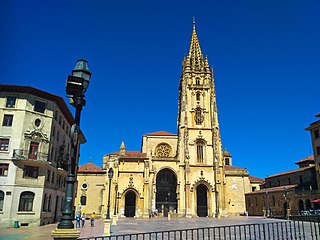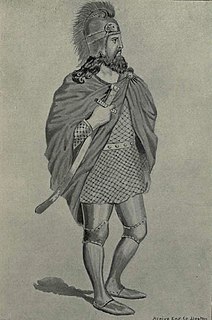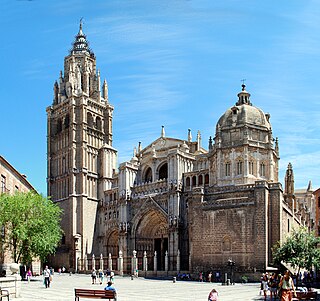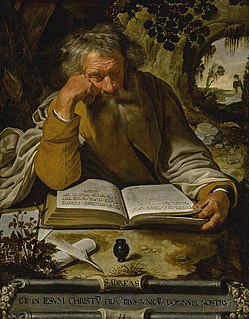
Isidore of Seville was a Spanish scholar and cleric. For over three decades, he was Archbishop of Seville. He is widely regarded, in the words of 19th-century historian Montalembert, as "the last scholar of the ancient world".

Toledo is a city and municipality of Spain, capital of the province of Toledo and the de jure seat of the government and parliament of the autonomous community of Castilla–La Mancha. Toledo was declared a World Heritage Site by UNESCO in 1986 for its extensive monumental and cultural heritage.

Oviedo is the capital city of the Principality of Asturias in northern Spain and the administrative and commercial centre of the region. It is also the name of the municipality that contains the city. Oviedo is located approximately 24 km (15 mi) southwest of Gijón and 23 km (14 mi) south of Avilés, both of which lie on the shoreline of the Bay of Biscay. Oviedo's proximity to the ocean of less than 30 kilometres (19 mi) in combination with its elevated position with areas of the city more than 300 metres above sea level causes the city to have a maritime climate, in spite of it not being located on the shoreline itself.

Julian of Toledo (642–690) was born in Toledo, Hispania,. He was well educated at the cathedral school, was a monk and later abbot at Agali, a spiritual student of Saint Eugene II, and archbishop of Toledo. He was the first bishop to have primacy over the entire Iberian Peninsula—a position he has been accused of securing by being complicit in 680 in the supposed poisoning of Wamba, king of the Visigoths—and he helped centralize the Iberian Church in Toledo. His elevation to the position of primate of the Visigothic church was a source of great unhappiness among the kingdom's clergy. And his views regarding the doctrine of the Trinity proved distressing to the Vatican.

Vardan Mamikonian was an Armenian military leader, a martyr and a saint of the Armenian Church. He is best known for leading the Armenian army at the Battle of Avarayr in 451, which ultimately secured the Armenians' right to practice Christianity.

Saint Ildefonsus or Ildephonsus was a scholar and theologian who served as the metropolitan Bishop of Toledo for the last decade of his life. His Gothic name was Hildefuns. In the Ethiopian Orthodox Tewahedo Church he is known as Saint Dexius based on the Ge'ez translation of the legends about his life.

The Catholic Church in Morocco is part of the worldwide Catholic Church, under the spiritual leadership of the Pope in Rome. Catholics account for only about .07% of the overall population of over 31 million. The country is divided into two archdioceses; Rabat and Tangier.

Saint Paulinus II was a priest, theologian, poet, and one of the most eminent scholars of the Carolingian Renaissance. From 787 to his death, he was the Patriarch of Aquileia. He participated in a number of synods which opposed Spanish Adoptionism and promoted both reforms and the adoption of the Filioque into the Nicene Creed. In addition, Paulinus arranged for the peaceful Christianisation of the Avars and the alpine Slavs in the territory of the Aquileian patriarchate. For this, he is also known as the apostle of the Slovenes.

Saint Leocadia is a Spanish saint. She is thought to have died on December 9, ca. 304, in the Diocletian persecution.

Yepes is a villa (town) in the northern region of the province of Toledo, in the autonomous community of Castile-La Mancha, Spain.

Masona or Mausona was the Bishop of Mérida and metropolitan of the province of Lusitania from about 570 until his death. He is famous for exercising de facto rule of the city of Mérida during his tenure as bishop and for founding the first confirmed hospital in Spain.

Saint Maurice was the leader of the legendary Roman Theban Legion in the 3rd century, and one of the favorite and most widely venerated saints of that group. He was the patron saint of several professions, locales, and kingdoms. He is also a revered saint in the Coptic Orthodox Church of Alexandria and other churches of Oriental Orthodoxy.

Cobeja is a municipality located in the province of Toledo, Castile-La Mancha, Spain. According to the 2006 census (INE), the municipality has a population of 2047 inhabitants.

The Primate Cathedral of Saint Mary of Toledo, otherwise Toledo Cathedral, is a Roman Catholic church in Toledo, Spain. It is the seat of the Metropolitan Archdiocese of Toledo.

Andrew the Apostle, also called Saint Andrew, was an apostle of Jesus according to the New Testament. He is the brother of Saint Peter. He is referred to in the Orthodox tradition as the First-Called.

Saint Peter and Saint Paul is a painting by the Cretan-Spanish artist El Greco. The work was completed between 1590 and 1600. It is currently on display at the Museu Nacional d'Art de Catalunya, who purchased the work in 1932.

The Church of San Ildefonso is a Baroque style church located in the historic center of the city of Toledo, in Castile-La Mancha, Spain. It is also known as the Jesuit church and is consecrated to Saint Ildefonso of Toledo, patron of the city and Father of the Church.

The Iglesia de Santa Leocadia is a church located in Toledo, in Castile-La Mancha, Spain. The Toledan tradition maintains that this church is built on the site of the house where Saint Leocadia of Toledo was born, to which would belong a small underground room, where it is affirmed that it made prayer. This cave corresponds to the crypt located next to the right pillar of the presbytery, and is covered with a plaster crossery vault, which can be dated in the first half of the 16th century. In the tower and in the facade of the church are preserved, embedded, some fragments of reliefs in Visigothic style.

The Convento de Santa Clara la Real is a convent of the Poor Clares located in the city of Toledo, Castile-La Mancha, Spain. The present convent was founded in the middle of the 14th century by Toledan noblewoman María Meléndez, and is located near other monasteries of note, such as the monastery of Santo Domingo el Real and the Convent of Capuchins of Toledo.

Saint Louis is a 1592–1595 painting by El Greco, painted during his time in Toledo. It is now in the Louvre in Paris.



















